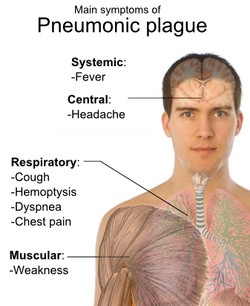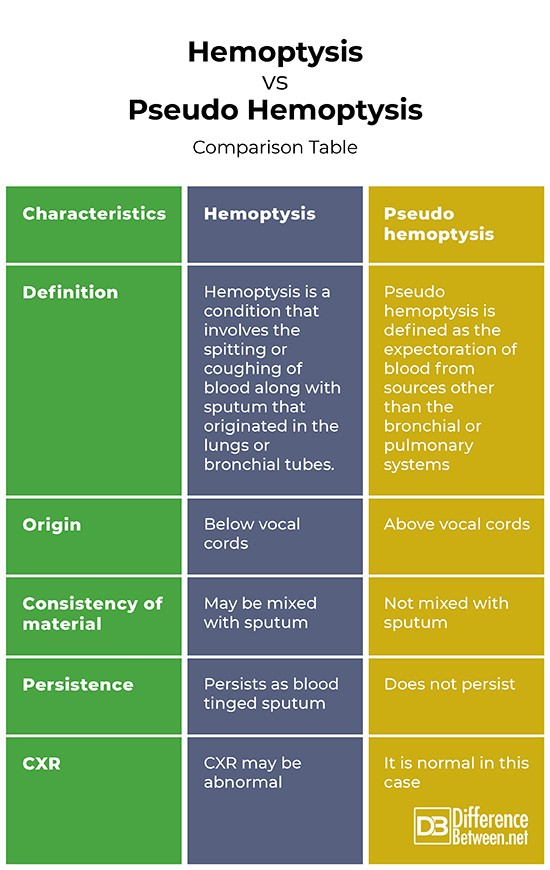Difference Between Hemoptysis and Pseudo Hemoptysis
What are Hemoptysis and Pseudo hemoptysis?
Hemoptysis is a condition in which small amounts of blood mixed with sputum (blood-stained mucus from the lungs, trachea, bronchi or larynx) are brought up by a forceful cough. Pseudo hemoptysis is another name of false hemoptysis. Pseudo hemoptysis is defined as the expectoration (to eject blood from the throat or lungs by spitting, coughing or hawking) of blood from sources other than the bronchial or. pulmonary systems. Similarly, its etiologies (the study of causation or origination) are often. inflammatory, neoplastic (relating to a neoplasm or neoplasia), vascular or traumatic in origin.

Hemoptysis
Hemoptysis is defined as the expectoration (ejection of blood from the throat or lungs by spitting, coughing or hawking) of blood which is derived from the lungs or bronchi and arises as a result of pulmonary (relating to the lungs) or bronchial hemorrhage (an acute bleeding from the lung). The causes of hemoptysis are numerous and may be related to processes intrinsic to the pulmonary system or may have their origin in diseases that secondarily involve the lungs. Bronchitis, pneumonia, and tuberculosis are pulmonary infectious processes that frequently precipitate hemoptysis. Neoplastic causes include a variety of primary lung cancers or malignant tumors metastatic (cancer spreading to a different body part from where it started) from any location in the body. Cardiovascular (heart related), thromboembolic, and traumatic etiologies are less frequent causes of hemoptysis.

Pseudo Hemoptysis?
When red colored sputum is visible without the actual presence of RBCs (red blood cells), due to the manifestation of red pigment forming bacteria called Serratia marcescens infection, the condition is pseudo or false hemoptysis. Similarly, its etiologies are often inflammatory, neoplastic, vascular or traumatic in origin.
Difference between Hemoptysis and Pseudo hemoptysis
Description
Hemoptysis
Hemoptysis (means “spitting up blood”) is the expectoration (the act of coughing up and spitting out the material produced in the respiratory tract) of blood or blood-tinged sputum from the lungs or tracheobronchial tree.
The blood can appear as flecks (mark or dot with small patches of colour), streaks or can be quite massive in amount.
Pseudo hemoptysis
Pseudo hemoptysis (aka false pseudo hemoptysis) is defined as the expectoration (to eject blood from the throat or lungs by spitting, coughing or hawking) of blood from sources other than the bronchial or. pulmonary systems. Similarly, its etiologies (the study of causation or origination) are often. inflammatory, neoplastic (relating to a neoplasm or neoplasia), vascular or traumatic in origin.
Causes
Hemoptysis
Infections
- Bronchitis (an inflammation of the lining of the bronchial tubes)
- Fungus
- Pneumonia (Infection that fills fluid in the lungs and inflames air sacs in one or both lungs)
- Tuberculosis (A potentially severe infectious bacterial infection that mainly affects the lungs)
- Lung abscess (a type of liquefactive necrosis of the lung tissue)
- Bronchiectasis (a long-term lung disease where impaired airways cause mucus build-up and reoccurrence of lung infections)
Tumors
- Bronchial cancer
- Carcinoid
Cardiovascular
- Lung infarct
- Mitral stenosis (a narrowing of the heart’s mitral valve)
Trauma
Other
- Foreign body
- Hemorrhagic diatesis (Bleeding tendencies accompanied by hepatic failure)
- Goodpasture and other immunological disorders (diseases or conditions caused by a dysfunction of the immune system)
Pseudo hemoptysis
- Blood coming from the pharynx
- Aspiration from hemoptysis (coughing blood)
- Colonization by red pigment forming bacteria (gram negative bacteria) – serratia marcescens (coloration of sputum)
- Patients may not be able to describe and inform about their source (location in this case) of bleeding and blood arising from the nares (the nostrils), oral cavity (the lips, the inside lining of the cheeks and lips (buccal mucosa), the teeth, the gums), tongue and pharynx penetrate into the larynx to stimulate the cough reflex.
- Factitious hemoptysis – in such situation, the episodes of hemoptysis are self-inflicted, and this may result in unrequired and extensive diagnostic work-up – Pseudo hemoptysis
Clinical features
Hemoptysis
- Origin of blood – Respiratory tract
- Cough – More likely
- Respiratory symptoms – More likely
- Esophagogastric symptoms – Less likely
- Alcohol use, hepatic disease – Less likely
- Vomiting, nausea – Less likely
- Hematemesis and melena – Less likely
- Color of expectorated blood – Bright red
- Consistency of expectorate – Clotted or liquid
- Frothiness of expectorate – Usually
- pH of expectorate – Alkaline
- PAM (pulmonary alveolar macrophage) in sputum – Present
- Food particles in expectorate – Absent
Pseudo hemoptysis
- Origin of blood – Oral cavity, larynx, esophagus, stomach, fictitious
- Cough – Less likely
- Respiratory symptoms – Less likely
- Esophagogastric symptoms – More likely
- Alcohol use, hepatic disease – More likely
- Vomiting, nausea – More likely
- Hematemesis and melena – More likely
- Color of expectorated blood – Brown or black
- Consistency of expectorate – Coffee grounds appearance
- Frothiness of expectorate – Never or seldom
- pH of expectorate – Acidic
- PAM (pulmonary alveolar macrophage) in sputum – Absent
- Food particles in expectorate – Present
Summary
The points of difference between Hemoptysis and Pseudo hemoptysis have been summarized as below:
Hemoptysis Vs. Pseudo hemoptysis: Comparison Table

- Difference Between Global Warming and Greenhouse Effect - May 18, 2024
- Difference Between Vaccination and Immunization - March 3, 2024
- Difference Between Selective Mutism and Autism - February 25, 2024
Search DifferenceBetween.net :
Leave a Response
References :
[0]Bidwell, J. L., & Pachner, R. W. (2005). Hemoptysis: diagnosis and management. American family physician, 72(7), 1253-1260.
[1]DiLeo, M. D., Amedee, R. G., & Butcher, R. B. (1995). Hemoptysis and pseudo hemoptysis: the patient expectorating blood. Ear, nose & throat journal, 74(12), 822-830.
[2]Earwood, J. S., & Thompson, T. D. (2015). Hemoptysis: evaluation and management. American family physician, 91(4), 243-249.
[3]GREGORY, T. (1999). A systematic approach to hemoptysis. Patient Care, 33(15), 49-49.
[4]Image credit: https://lh3.googleusercontent.com/proxy/xQ1eXbcQEqpt3XrlaL2eKc-glp4qyKkIMh5qy6t7_Pff20RsDiF-OdYy1kP2i4HCUwDXlKdCPR9i-9zBbTPmtyHZZjcF8YBzrodCu30u3spIVzF3TSmIKw
[5]Image credit: https://commons.wikimedia.org/wiki/File:Pneumonic_plague.jpg
[6]Image credit: https://commons.wikimedia.org/wiki/File:Pneumonic_plague.jpg
